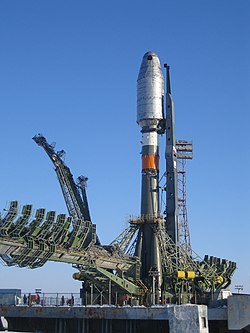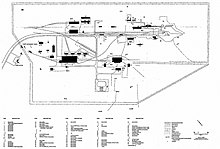45°59′46″N 63°33′51″E / 45.99611°N 63.56417°E
 A Soyuz 2 rocket at LC-31/6 | |||||||||||||
 | |||||||||||||
| Launch site | Baikonur Cosmodrome | ||||||||||||
|---|---|---|---|---|---|---|---|---|---|---|---|---|---|
| Location | Kazakhstan | ||||||||||||
| Time zone | UTC+5 (AQTT) | ||||||||||||
| Operator | Strategic Missile Forces, Russian Aerospace Forces, Roscosmos | ||||||||||||
| Launch pad(s) | 1 | ||||||||||||
| Orbital inclination range | 49–99° | ||||||||||||
| |||||||||||||
Baikonur Site 31, also known as Site 31/6 at the Baikonur Cosmodrome, in Kazakhstan, is a launch site used by derivatives of the R-7 Semyorka missile. Since Roscosmos' change from flying crew on the Soyuz-FG to the Soyuz-2 launch vehicle for crewed flights in 2020, it has served as the primary launch site for Soyuz flights to the International Space Station. It took over from Site 1/5 (Gagarin's Start) after the latter failed to receive funding to modernize it for the slightly larger Soyuz-2 rocket.[1][verification needed]
Before that, it only saw a handful of crewed flights when Site 1/5 was unavailable (Soyuz TMA-06M, Soyuz TMA-15M, Soyuz MS-02).
It was first used on 14 January 1961, for an R-7A ICBM test mission. As of 2023 it is currently used for Soyuz-2 launches. In the 1970s and early 1980s, several crewed missions were launched from the site.

See also
edit- Gagarin's Start (Baikonur Site 1)
References
edit- ^ Berger, Eric (16 October 2023). "After six decades, 'Gagarin's Start' will meet its end as a launch pad". Ars Technica. Retrieved 24 October 2023.
- "Baikonur LC31". Encyclopedia Astronautica. Archived from the original on 4 September 2003.
Further reading
edit- J. K. Golovanov, "Korolev: Facts and myths", Nauka, 1994, ISBN 5-02-000822-2;
- "Rockets and people" – B. E. Chertok, M: "mechanical engineering", 1999 ISBN 5-217-02942-0 (in Russian);
- «A breakthrough in space» - Konstantin Vasilyevich Gerchik, M: LLC "Veles", 1994 - ISBN 5-87955-001-X;
- "Testing of rocket and space technology - the business of my life" Events and facts - A.I. Ostashev, Korolyov, 2001 [1];
- "Baikonur. Korolev. Yangel" - M. I. Kuznetsk, Voronezh: IPF "Voronezh", 1997, ISBN 5-89981-117-X;
- "Look back and look ahead. Notes of a military engineer" - Rjazhsky A. A., 2004, SC. first, the publishing house of the "Heroes of the Fatherland" ISBN 5-91017-018-X.
- "Rocket and space feat Baikonur" - Vladimir Порошков, the "Patriot" publishers 2007. ISBN 5-7030-0969-3
- "Unknown Baikonur" - edited by B. I. Posysaeva, M.: "globe", 2001. ISBN 5-8155-0051-8
